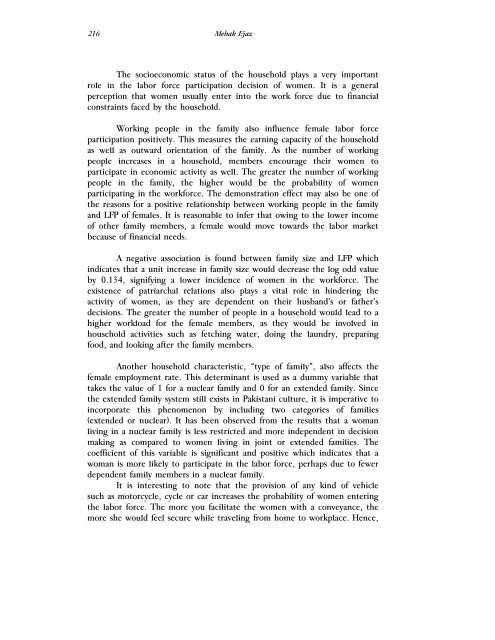Special Edition-07.pdf - Lahore School of Economics
Special Edition-07.pdf - Lahore School of Economics
Special Edition-07.pdf - Lahore School of Economics
Create successful ePaper yourself
Turn your PDF publications into a flip-book with our unique Google optimized e-Paper software.
216<br />
Mehak Ejaz<br />
The socioeconomic status <strong>of</strong> the household plays a very important<br />
role in the labor force participation decision <strong>of</strong> women. It is a general<br />
perception that women usually enter into the work force due to financial<br />
constraints faced by the household.<br />
Working people in the family also influence female labor force<br />
participation positively. This measures the earning capacity <strong>of</strong> the household<br />
as well as outward orientation <strong>of</strong> the family. As the number <strong>of</strong> working<br />
people increases in a household, members encourage their women to<br />
participate in economic activity as well. The greater the number <strong>of</strong> working<br />
people in the family, the higher would be the probability <strong>of</strong> women<br />
participating in the workforce. The demonstration effect may also be one <strong>of</strong><br />
the reasons for a positive relationship between working people in the family<br />
and LFP <strong>of</strong> females. It is reasonable to infer that owing to the lower income<br />
<strong>of</strong> other family members, a female would move towards the labor market<br />
because <strong>of</strong> financial needs.<br />
A negative association is found between family size and LFP which<br />
indicates that a unit increase in family size would decrease the log odd value<br />
by 0.134, signifying a lower incidence <strong>of</strong> women in the workforce. The<br />
existence <strong>of</strong> patriarchal relations also plays a vital role in hindering the<br />
activity <strong>of</strong> women, as they are dependent on their husband’s or father’s<br />
decisions. The greater the number <strong>of</strong> people in a household would lead to a<br />
higher workload for the female members, as they would be involved in<br />
household activities such as fetching water, doing the laundry, preparing<br />
food, and looking after the family members.<br />
Another household characteristic, “type <strong>of</strong> family”, also affects the<br />
female employment rate. This determinant is used as a dummy variable that<br />
takes the value <strong>of</strong> 1 for a nuclear family and 0 for an extended family. Since<br />
the extended family system still exists in Pakistani culture, it is imperative to<br />
incorporate this phenomenon by including two categories <strong>of</strong> families<br />
(extended or nuclear). It has been observed from the results that a woman<br />
living in a nuclear family is less restricted and more independent in decision<br />
making as compared to women living in joint or extended families. The<br />
coefficient <strong>of</strong> this variable is significant and positive which indicates that a<br />
woman is more likely to participate in the labor force, perhaps due to fewer<br />
dependent family members in a nuclear family.<br />
It is interesting to note that the provision <strong>of</strong> any kind <strong>of</strong> vehicle<br />
such as motorcycle, cycle or car increases the probability <strong>of</strong> women entering<br />
the labor force. The more you facilitate the women with a conveyance, the<br />
more she would feel secure while traveling from home to workplace. Hence,

















